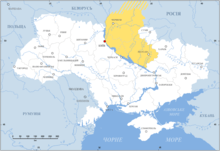Left-bank Ukraine
Left-bank Ukraine (Ukrainian: Лівобережна Україна, romanized: Livoberezhna Ukrayina; Russian: Левобережная Украина, romanized: Levoberezhnaya Ukraina; Polish: Lewobrzeżna Ukraina) is a historic name of the part of Ukraine on the left (East) bank of the Dnieper River, comprising the modern-day oblasts of Chernihiv, Poltava and Sumy as well as the eastern parts of Kyiv and Cherkasy.

Part of a series on the |
|---|
| History of Ukraine |
 |
|
Early history
|
|
Modern history
|
|
Topics by history |
|
|
The term appeared in 1663 with the election of Ivan Bryukhovetsky as the hetman of Ukraine in opposition to Pavlo Teteria. Bryukhovetsky was the first known "left-bank Ukraine" hetman over the area that was under the Russian influence.
Until the mid-17th century the area belonged to the Polish-Lithuanian Commonwealth, and since the Treaty of Pereyaslav of 1654, besides of its southern part (part of Taurida), it fell under Russian control, later reaffirmed in the Treaty of Andrusovo (1667) and the Eternal Peace Treaty (1686) between the Polish-Lithuanian Commonwealth and Tsardom of Russia. Under the Russian rule, the left-bank Ukraine initially enjoyed a degree of autonomy within the Tsardom (from 1721, Imperial Russia) as the Cossack Hetmanate, which was slowly withdrawn throughout the eighteenth century when the Zaporizhian Sich was destroyed.[1][2]
Related article
References
- Orest Subtelny; Ukraine History; University of Toronto Press; 2000. ISBN 0-8020-8390-0. pp 117-145-146-148
- Wiki article on destruction of the Sich (in English)